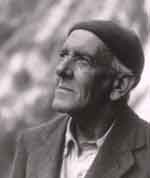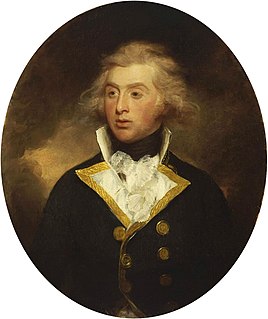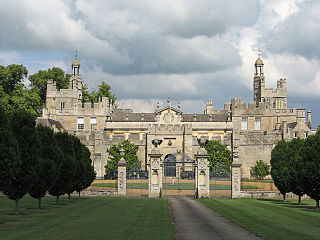This article does not cite any sources .(April 2015) (Learn how and when to remove this template message) |
This article does not cite any sources .(April 2015) (Learn how and when to remove this template message) |

Thomas Graham Brown FRS was a Scottish mountaineer and physiologist.

George Claridge Druce, MA, LLD, JP, FRS, FLS was an English botanist and a Mayor of Oxford.

Sebastian Pietro Innocenzo Adhemar Ziani de Ferranti was a British electrical engineer and inventor.
The Treasurer of the Household is a member of the Royal Household of the Sovereign of the United Kingdom. The position is usually held by one of the government deputy Chief Whips in the House of Commons. The Treasurer was a member of the Board of Green Cloth, until the Board of Green Cloth disappeared in the reform of local government licensing in 2004, brought about by the Licensing Act 2003.
The Earl of Courtown, in the County of Wexford, is a title in the Peerage of Ireland. It was created on 12 April 1762 for James Stopford, 1st Baron Courtown. He had previously represented County Wexford and Fethard in the Irish House of Commons. Stopford had already been created Baron Courtown, of Courtown in the County of Wexford, on 19 September 1758, and was made Viscount Stopford at the same time he was given the earldom. These titles are also in the Peerage of Ireland. He was succeeded by his eldest son, the second Earl. He was a Tory politician and served under William Pitt the Younger as Treasurer of the Household from 1784 to 1793. On 7 June 1796 he was created Baron Saltersford, of Saltersford in the County Palatine of Chester, in the Peerage of Great Britain. This title gave him and his descendants an automatic seat in the House of Lords.

Admiral Sir Robert Stopford, was a distinguished officer in the Royal Navy whose career spanned over 60 years, from the French Revolutionary Wars to the Syrian War.
Lieutenant General Sir Frederick William Stopford, was a British Army officer, best remembered for commanding the Suvla Bay landing in August 1915 during the Gallipoli Campaign.

Sir Thomas Lauder Brunton, 1st Baronet, was a Scottish physician who is most-closely associated with the use of amyl nitrite to treat angina pectoris.

Vice-Admiral of England Sir Thomas Spert was a mariner who reached the rank of vice admiral in service to King Henry VIII of England. He was sailing master of the flagships Mary Rose and Henry Grace a Dieu. He served as the first Master of Trinity House, the private corporation for maritime affairs in London. Spert Island off the coast of Antarctica is named for him.

James Stopford, 2nd Earl of Courtown KP, PC (Ire), known as Viscount Stopford from 1762 to 1770, was an Anglo-Irish peer and Tory politician who sat in the British House of Commons between 1774 and 1793.
James George Stopford, 3rd Earl of Courtown KP, PC, known as Viscount Stopford from 1770 to 1810, was an Anglo-Irish peer and Tory politician.
Sir Edward Stopford (1766–1837) was an Anglo-Irish soldier and politician.
James Thomas Stopford, 4th Earl of Courtown, known as Viscount Stopford from 1810 to 1835, was an Anglo-Irish peer and Tory member of parliament.
Vice-Admiral The Hon. Sir Montagu Stopford KCB was an officer in the Royal Navy.
Events from the year 1700 in Ireland.

John Sebastian Bach Stopford, Baron Stopford of Fallowfield KBE FRCS FRCP FRS was a British peer, a physician and anatomist, and a Vice-Chancellor of the University of Manchester. Lord Stopford was described as "one of the greatest anatomists of this century".
The High Sheriff of King's County was the British Crown's judicial representative in King's County, Ireland from 1556, when King's County was created, until 1922, when the office was abolished in the new Free State and replaced by the office of Offaly County Sheriff. The sheriff had judicial, electoral, ceremonial and administrative functions and executed High Court Writs. In 1908, an Order in Council made the Lord-Lieutenant the Sovereign's prime representative in a county and reduced the High Sheriff's precedence. However the sheriff retained his responsibilities for the preservation of law and order in the county. The usual procedure for appointing the sheriff from 1660 onwards was that three persons were nominated at the beginning of each year from the county and the Lord Lieutenant then appointed his choice as High Sheriff for the remainder of the year. Often the other nominees were appointed as under-sheriffs. Sometimes a sheriff did not fulfil his entire term through death or other event and another sheriff was then appointed for the remainder of the year. The dates given hereunder are the dates of appointment. All addresses are in King's County unless stated otherwise.
The High Sheriff of Wexford was the British Crown's judicial representative in County Wexford, Ireland from the 16th century until 1922, when the office was abolished in the new Irish Free State and replaced by the office of Wexford County Sheriff. The sheriff had judicial, electoral, ceremonial and administrative functions and executed High Court Writs. In 1908, an Order in Council made the Lord-Lieutenant the Sovereign's prime representative in a county and reduced the High Sheriff's precedence. However the sheriff retained his responsibilities for the preservation of law and order in the county. The usual procedure for appointing the sheriff from 1660 onwards was that three persons were nominated at the beginning of each year from the county and the Lord Lieutenant then appointed his choice as High Sheriff for the remainder of the year. Often the other nominees were appointed as under-sheriffs. Sometimes a sheriff did not fulfil his entire term through death or other event and another sheriff was then appointed for the remainder of the year. The dates given hereunder are the dates of appointment. All addresses are in County Wexford unless stated otherwise.

Drayton House is a country house 1 mile (1.6 km) south-west of the village of Lowick, Northamptonshire, England.
The Custos Rotulorum of County Wexford was the highest civil officer in County Wexford.

Marlfield House, County Wexford is an Irish country house built in 1852 and was one of the two houses owned by the Earls of Courtown. It was a dower house on the Courtown estate and is a good example of a rural regency style house. Owning two residences was not uncommon for wealthy families during the 19th century and the Stopfords were no exception. Guests regularly came to stay at both Marlfield and Courtown House, the principal family home, located about three miles from Marlfield. The Stopford family was ultimately unable to support their lavish lifestyle and Courtown House no longer exists. Marlfield House was further improved in 1866 by James Thomas Stopford (1794-1858), fourth Earl of Courtown. The house has historic connections with James Walter Milles Stopford (1853-1933), sixth Earl of Courtown, Major James Richard Neville Stopford OBE (1877-1857), seventh Earl of Courtown, and James Montagu Burgoyne Stopford (1908-1975), eighth Earl of Courtown. It is now a hotel.
Mary Stopford, Countess of Courtown, formerly Mary Powys, was the wife of James Stopford, 2nd Earl of Courtown.
Mary Stopford, Countess of Courtown, formerly Lady Mary Scott, was the wife of James Stopford, 3rd Earl of Courtown, and the mother of the 4th Earl.